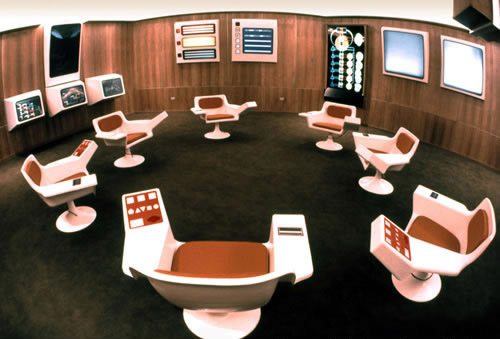Lost in the collateral damage of the 1973 coup d’etat in Chile that toppled Salvador Allende was Project Cybersyn, a singular computerized business control management system set up by British organizational guru Stafford Beer. “Cybersyn,” a portmanteau for Cybernetic Science, was an odd mélange of socialism, biology, business dynamics, computer science and space-age accoutrements. Telex machines in a Santiago-based control room (which seemed straight out of Star Trek) were used to sync up Chilean factories and provide real-time management for them. Its goal was no less than to regulate the entire national economy. It seems a questionable if fascinating idea whose time has finally arrived, for better or worse, with Big Data and quantification.
The control center was destroyed during the overthrow, but Beer’s influence went far beyond Chile or the business world; Brian Eno, an acolyte, wrote the forward to a collection of Beer essays. The following is an excerpt of Beer’s feelings about Project Cybersyn at its outset:
Dear friends, I should like to greet you personally to this place, in the development of which I have taken enormous personal interest, and for this reason I am asking you to take a special interest in it. What you see is the outcome of 18 months of hard work on the part of a group of extremely professional Chilean engineers who have devoted their efforts to solving corporate management problems. They have created for us a series of tools to help us in the task of controlling the economy. Modern science, and specifically electronic computer science, offers the Government a new opportunity to address modern economic problems. We have seen that the power of this science has not yet been used in the so-called developed countries. We have developed a system on our own. What you are about to hear today is revolutionary – not only because this is the first time that this is applied in the world – it is revolutionary because we are making a deliberate effort to give the people the power that science gives to us, enabling them to use it freely.•
From Eden Medina’s Jacobin piece “The Cybersyn Revolution,” which suggests lessons learned from the project we can apply today, a passage about the lo-fi nature of the future-forward system:
When Project Cybersyn was built during the 1970s, there were approximately fifty computers in all of Chile, and most were outdated. Nor could Chile call up IBM for help. IBM decreased its operations in Chile following Allende’s election because they feared the Chilean government would nationalize them. The Nixon administration had also instituted an “invisible blockade” to destabilize the Chilean economy and prevent Latin America from becoming a “red sandwich” with Cuba on one side and Chile on the other. This further limited Chile’s ability to import US technology.
As a result, Beer and the Chilean team came up with an ingenious way to create the data-processing network they needed to link the country’s factories to the central command center: they would connect the one outdated computer they had for the project to another technology that was not state-of-the-art: the telex machine — or rather, several hundred of them. And it worked.
In 1972, a national strike that grew to include forty thousand truck drivers threw the country into a state of emergency and disrupted the distribution of food, fuel, and raw materials for factory production. The government used the telex network created for Project Cybersyn to determine which roads were open, coordinate the distribution of key resources, and maintain factory production.
The Cybersyn network improved government communication and substantially increased the speed and frequency at which the government could send and receive messages along the length of the country. It lacked the technological sophistication of ARPANET, the US military communications system that was the forerunner of the Internet and a contemporary of Chile’s telex system. But the Chilean network used fewer technical resources at a lower cost and proved highly functional nonetheless. Older technologies were creatively re-envisioned and combined with other forms of organizational and social innovation.•
Tags: Eden Medina



